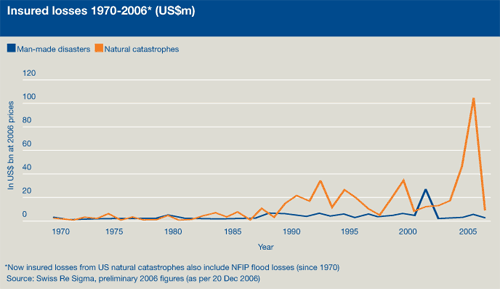Operating & Financial Review
2006 market overview
2006 industry loss activity
Following two extraordinary years in terms of catastrophe events, 2006 has proved to be a relatively benign year. According to Swiss Re Sigma, catastrophe losses of US$15 billion for the 2006 accident year compares to US$110 billion for 2005 and US$51 billion for 2004. The Atlantic hurricane season was especially favourable. Colorado State University had forecast 17 named storms for 2006, but there turned out to be only 9. There were no category 4 or 5 hurricanes and there was only 1 landfall event. These statistics make it the quietest year since 1997 and whilst it would be unrealistic to suggest that the cycle of activity for Atlantic hurricanes has reversed, it does show what an unpredictable science hurricane forecasting is.
There are three recognised meteorological theories as to why the 2006 year defied the dire predictions of the scientists. First, a late developing El Nino warm current in the Pacific Ocean reduced the conditions required for strong hurricane formation in the Atlantic. Second, there was the presence of African dry air accompanied by Saharan dust over the eastern Atlantic which is the area of cyclonic incubation. Finally, the storms which did form were forced northwards by the presence of a “Bermuda high”, which was a high pressure weather pattern that effectively blocked the westerly movement of storms, forcing them north into colder water.
In spite of the absence of a major hurricane, total insured damage from tornadoes in the US exceeded US$4.4 billion making it one of the worst years on record.

Property inflation and increased demand for rebuilding work means that even relatively minor events can have a serious economic impact. The scale and concentration of values in catastrophe zones in coastal regions of the US, Europe and Japan alongside the impact of climate change means that multi-billion dollar insurance losses are likely to be an increasing feature of our industry. The challenge for the insurer and reinsurer is to understand properly, model and price the exposure.
For Amlin the largest natural catastrophe loss was Cat 67 (March US Tornadoes) which is estimated to have incurred US$10 million of losses, a fraction of our net 2005 hurricane losses estimated now at US$256 million.
